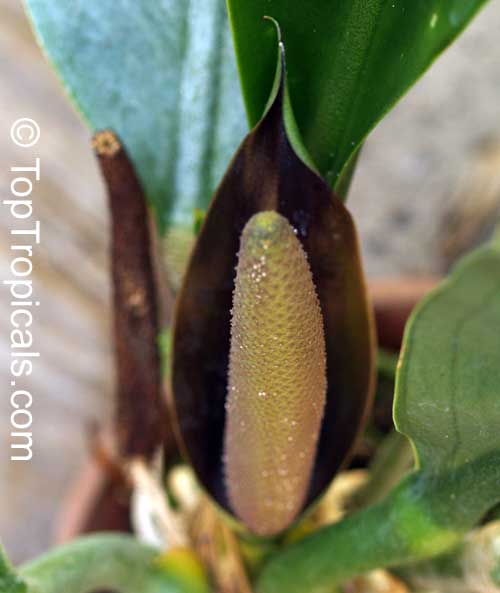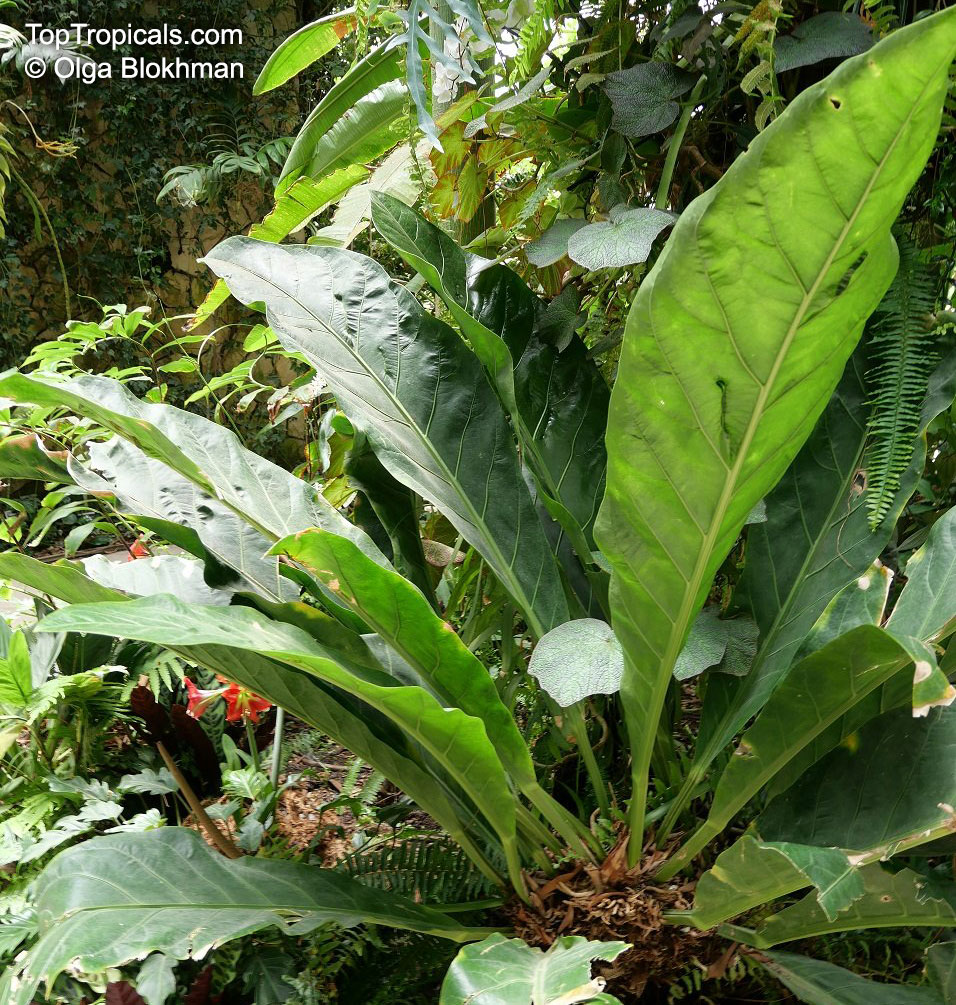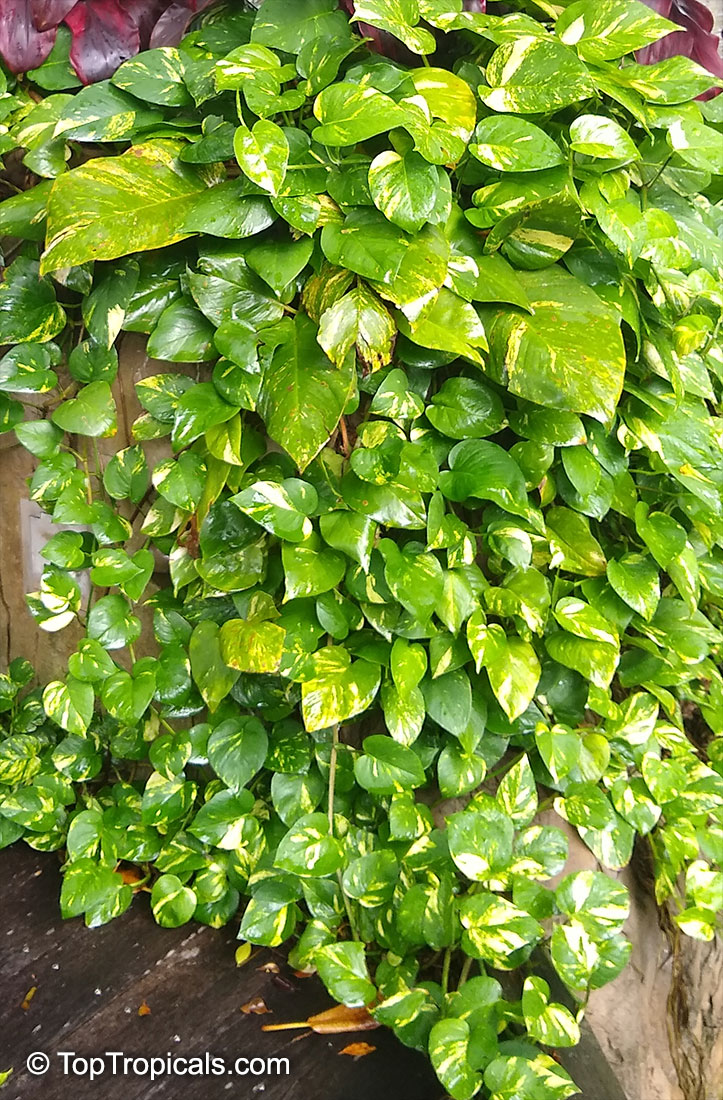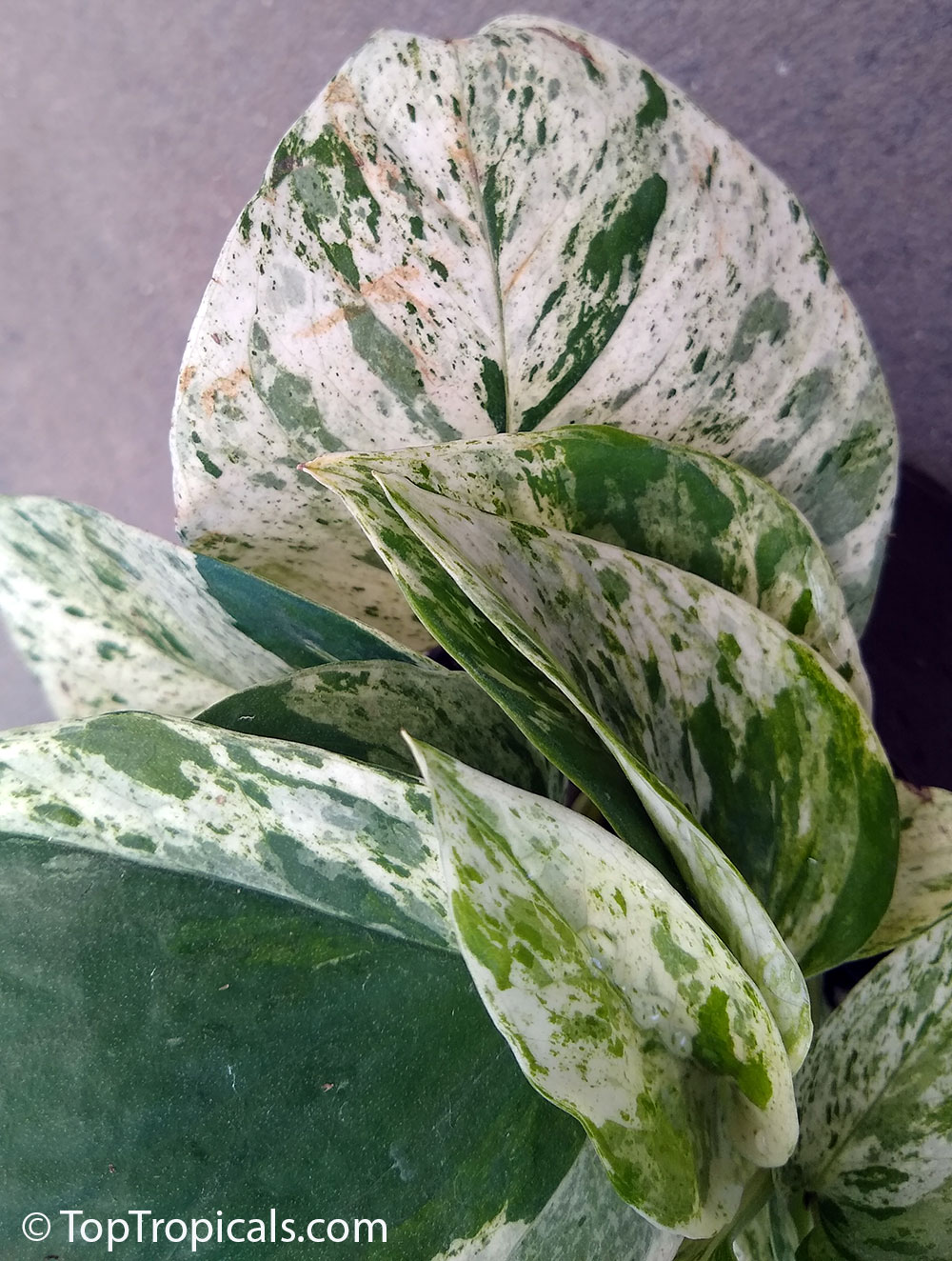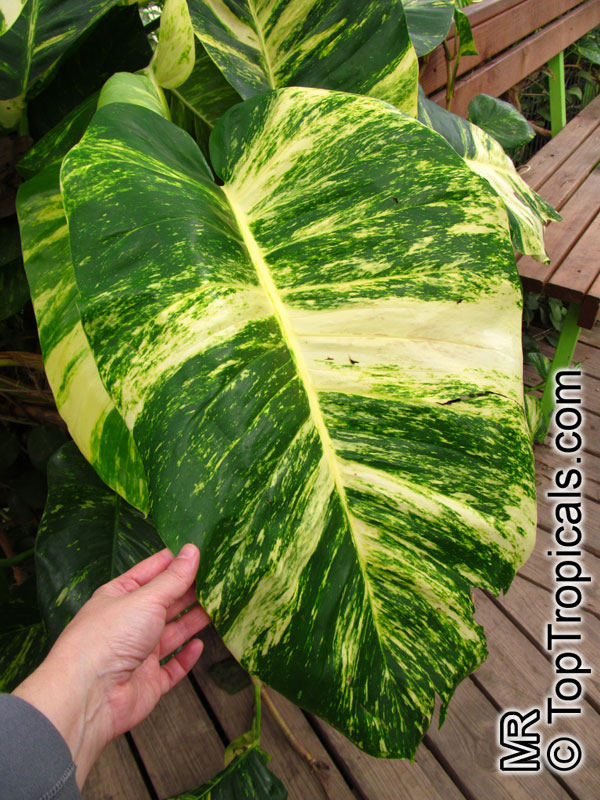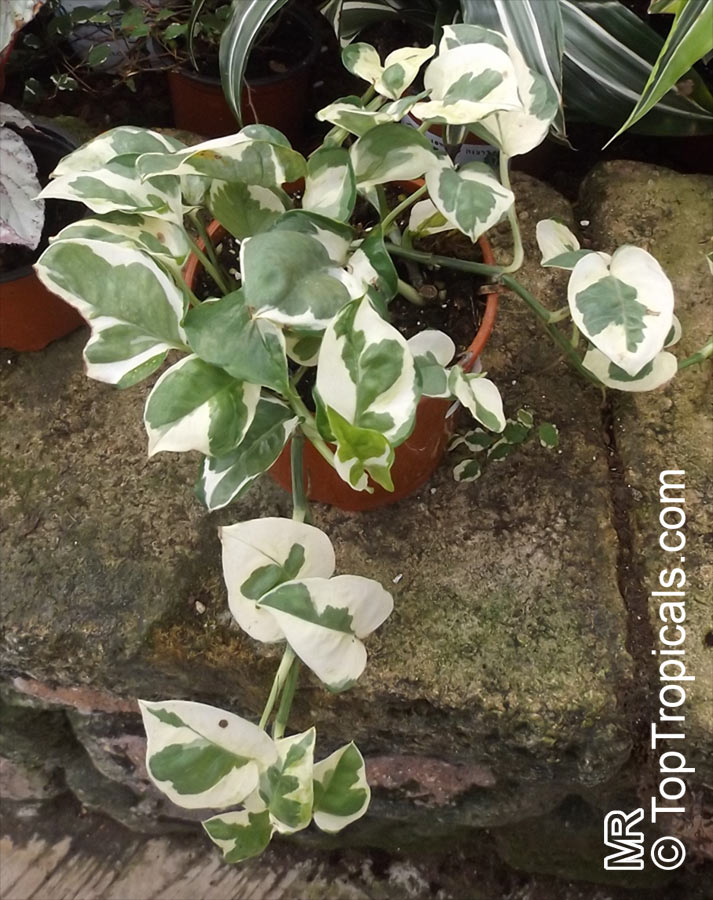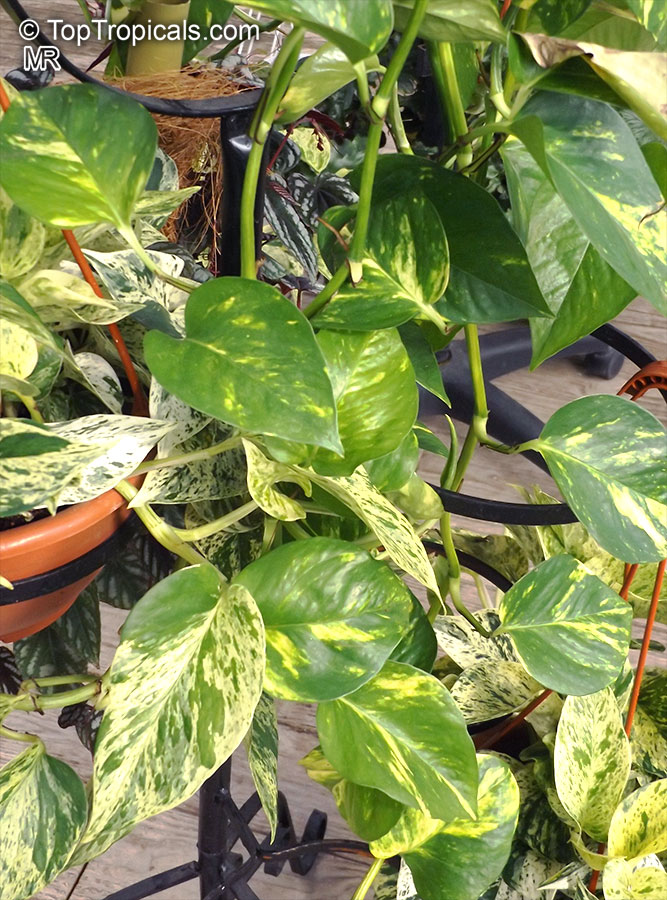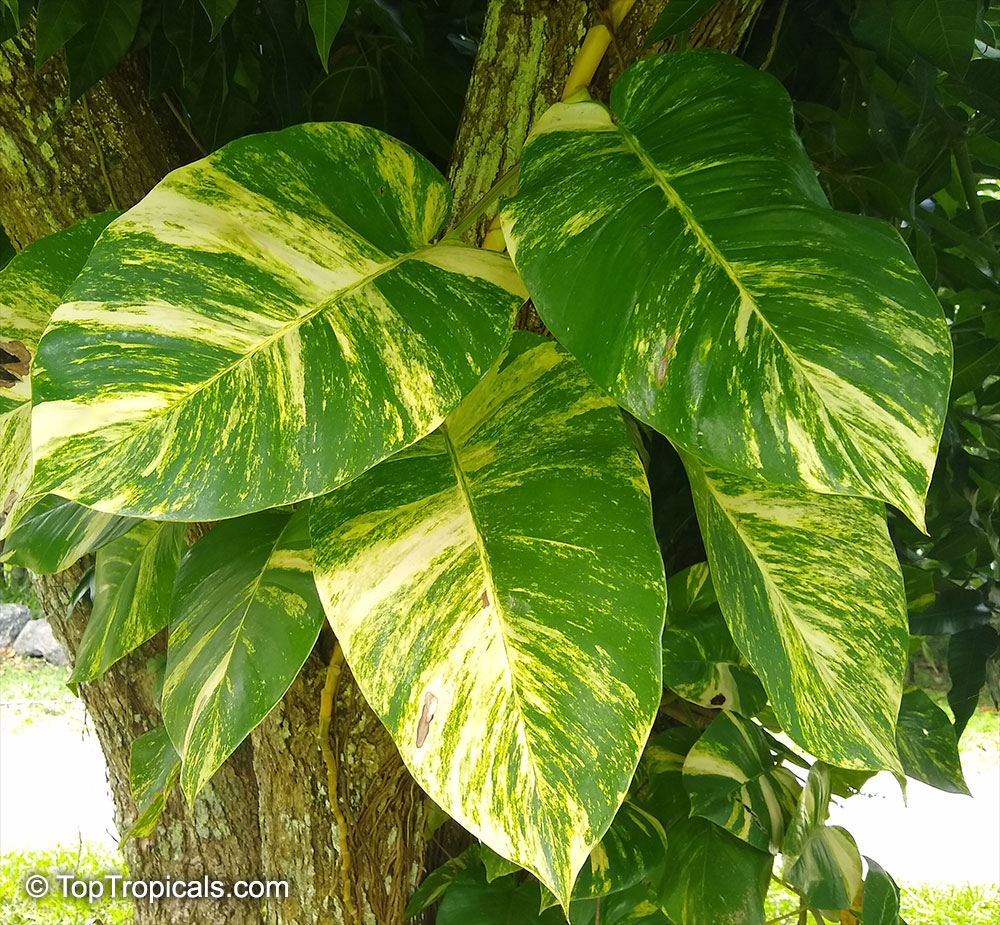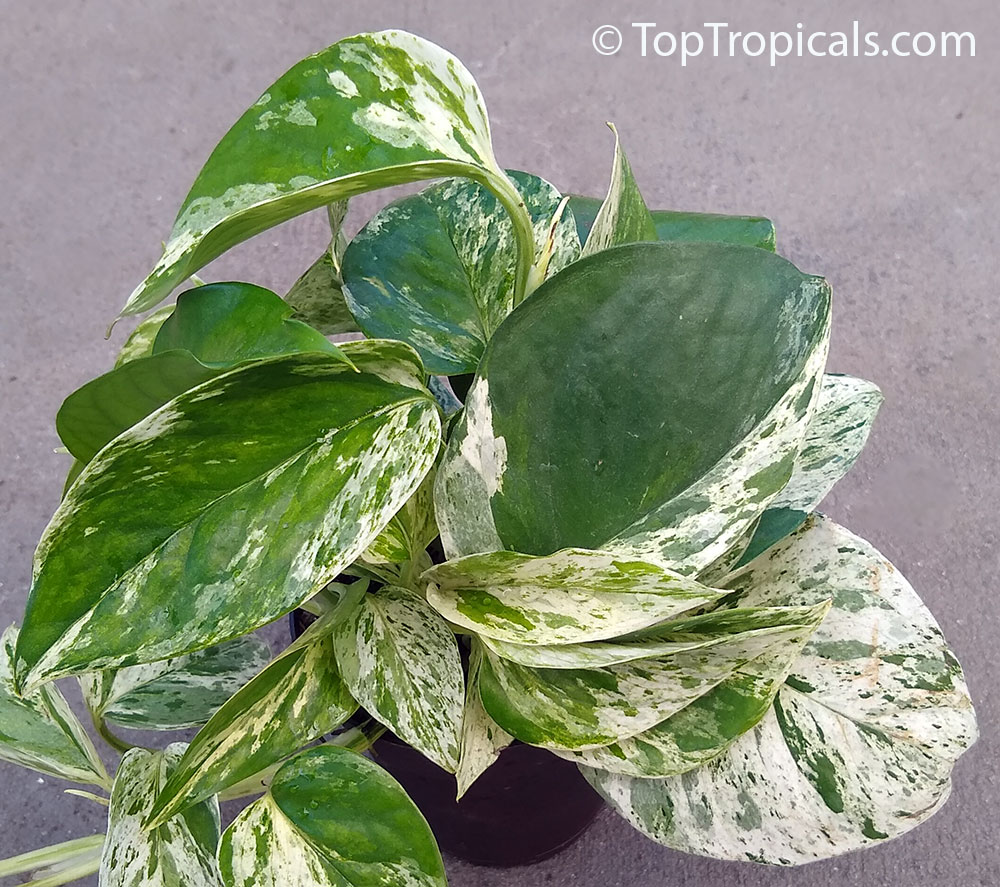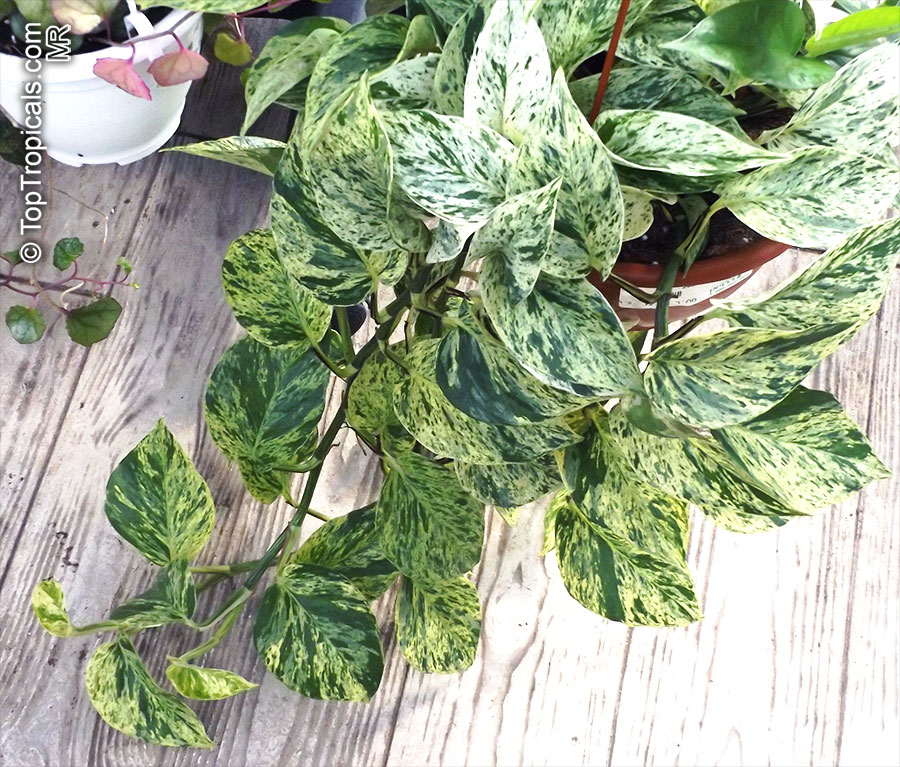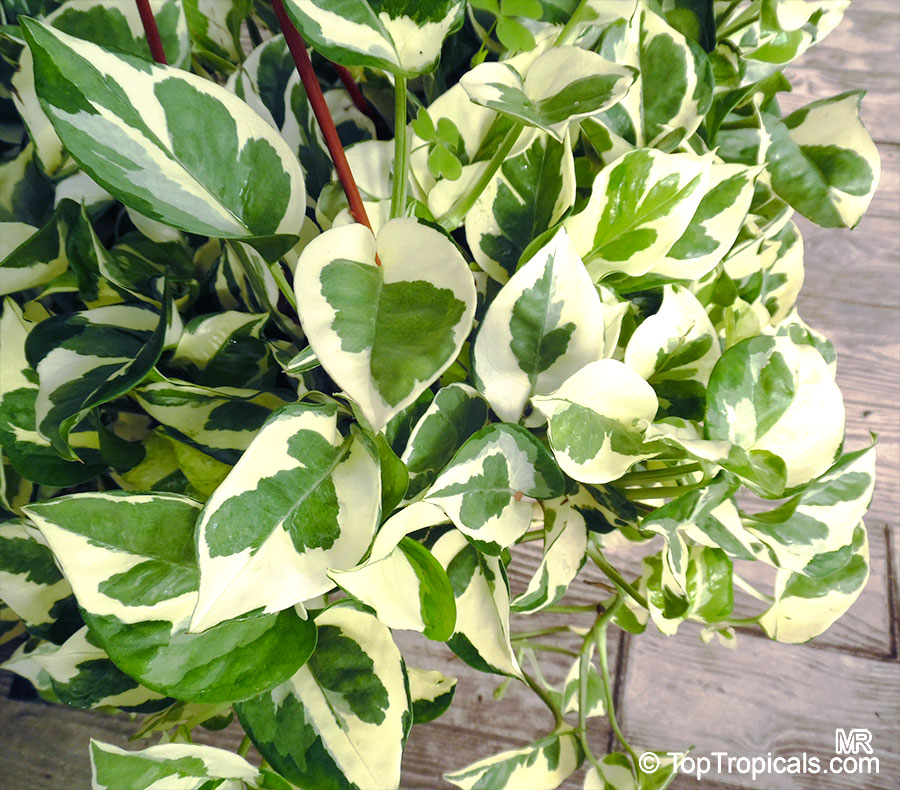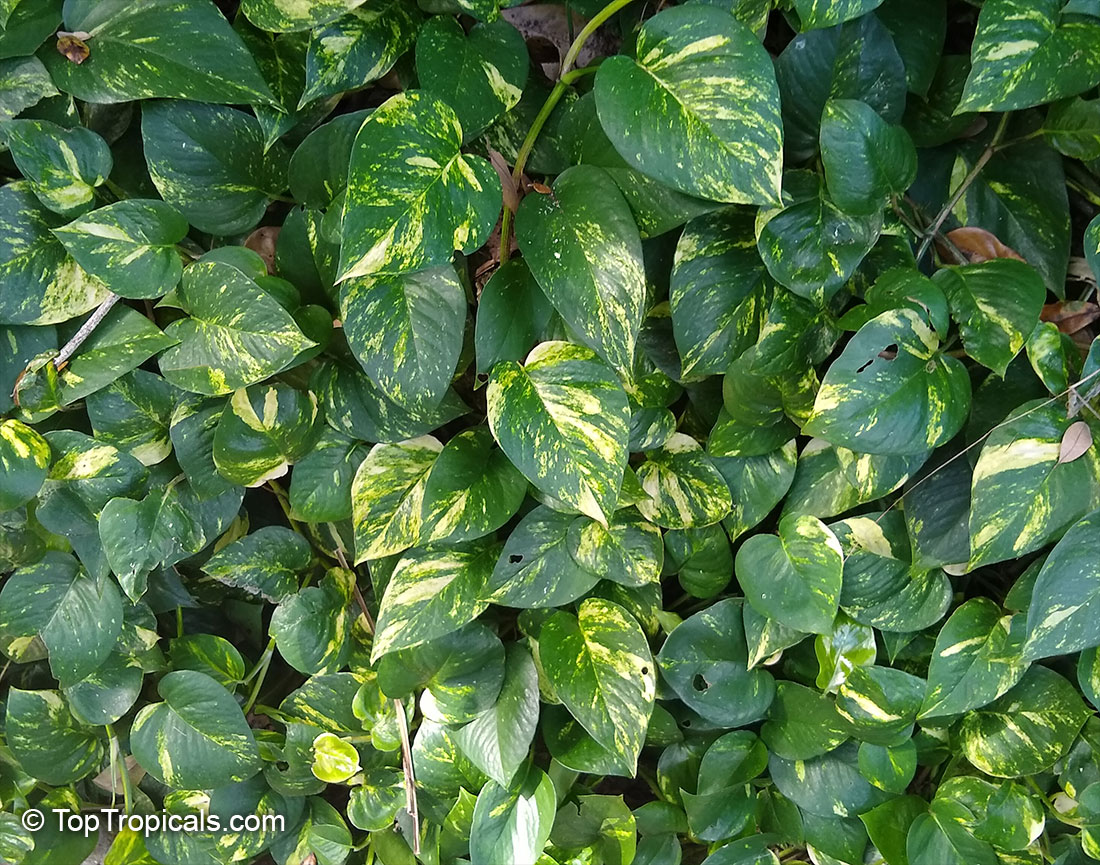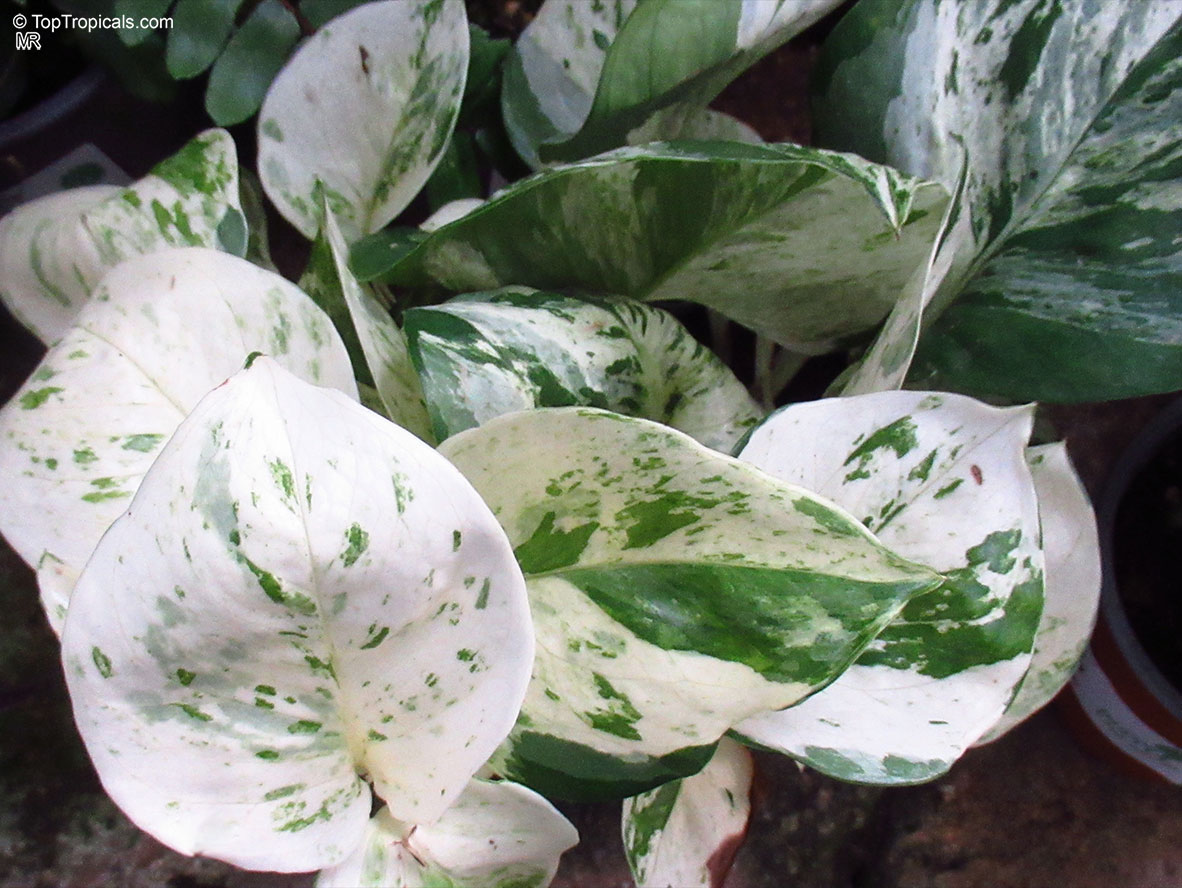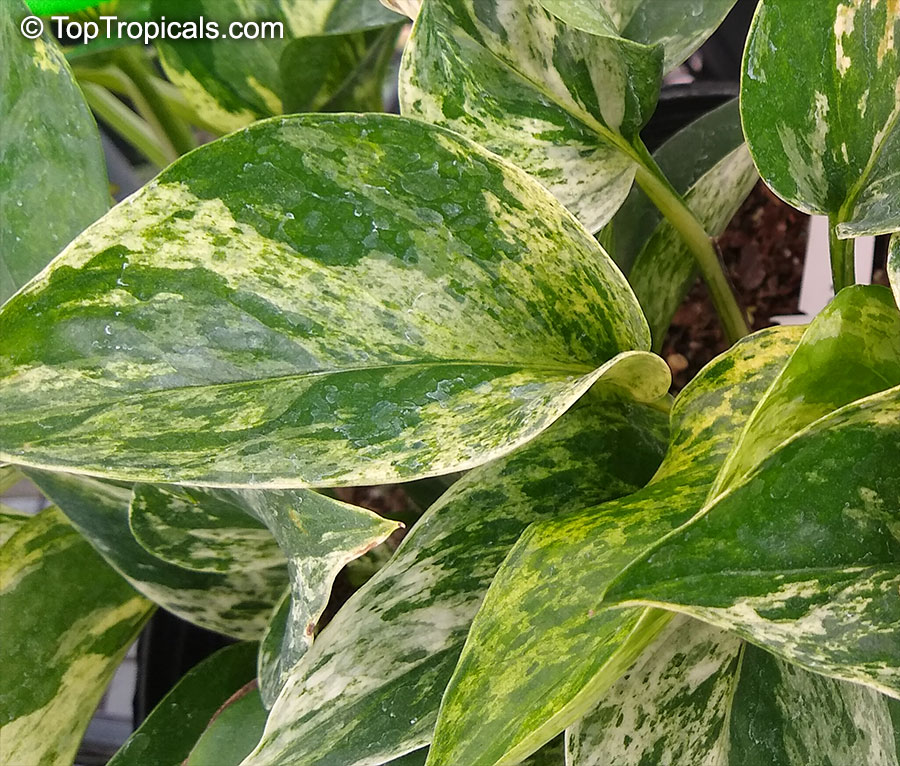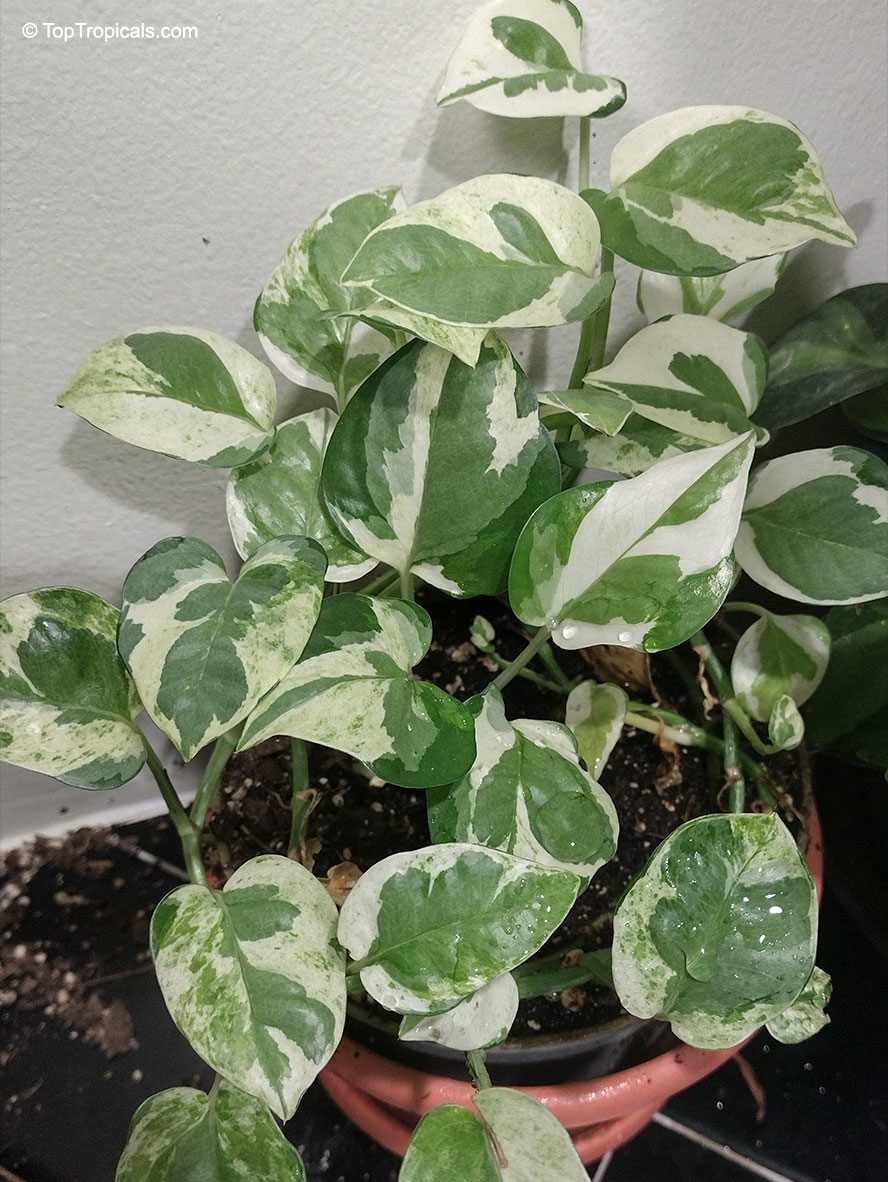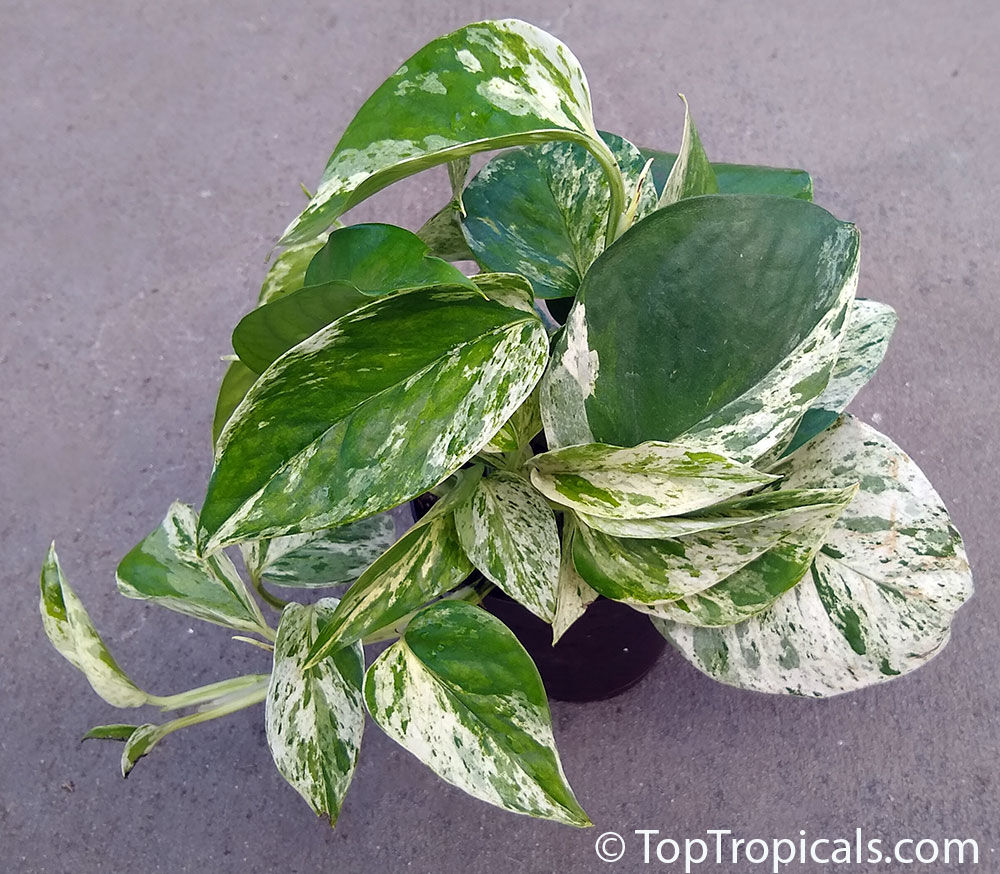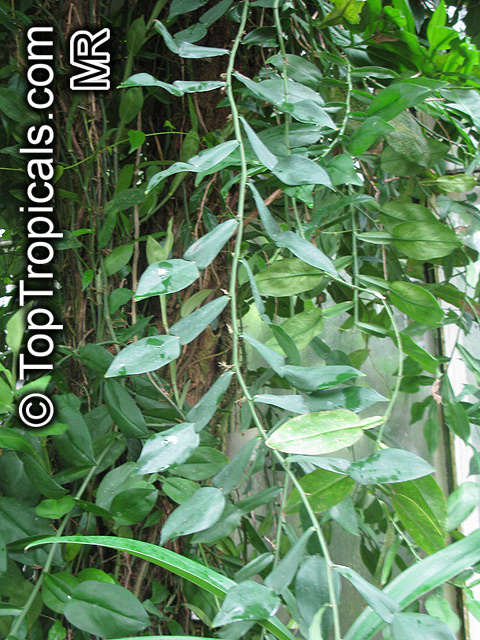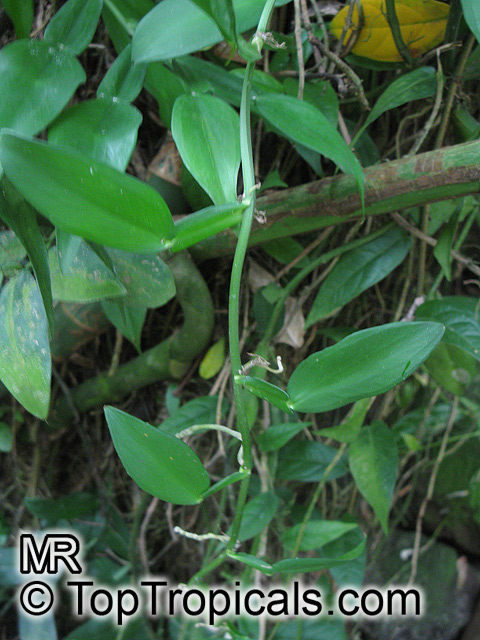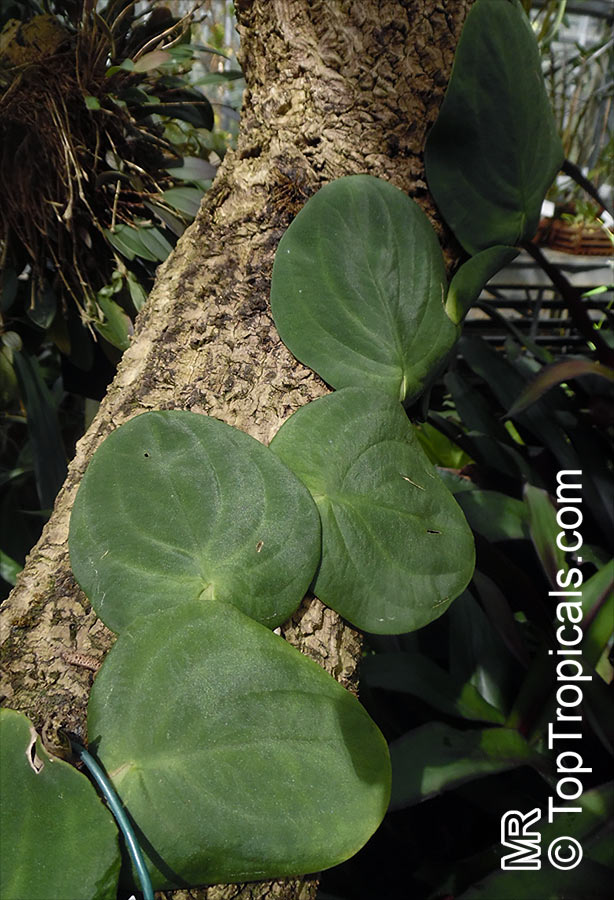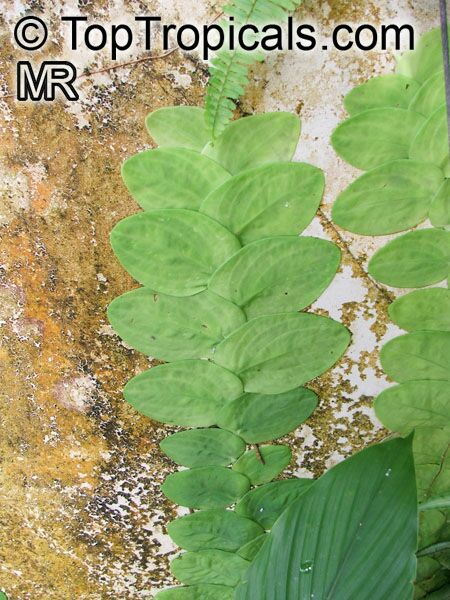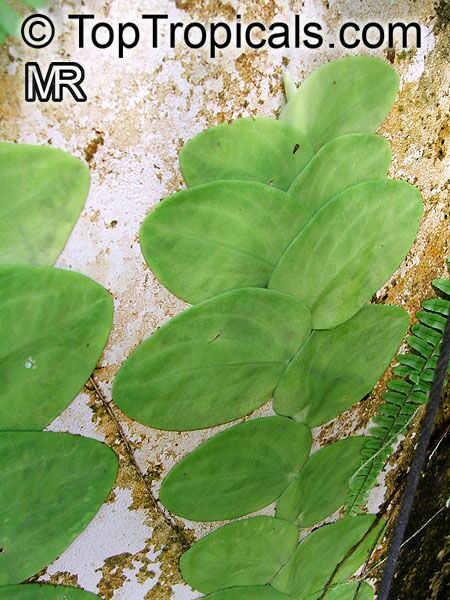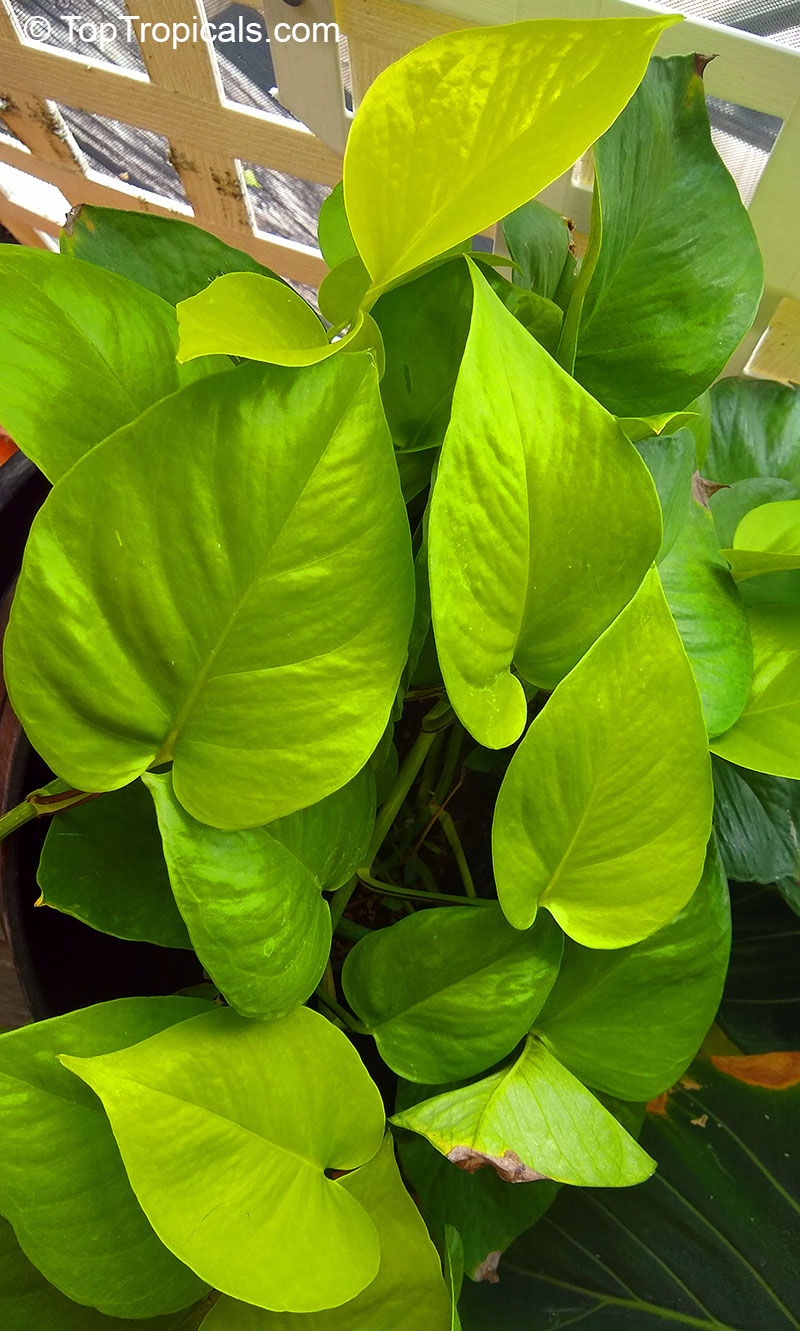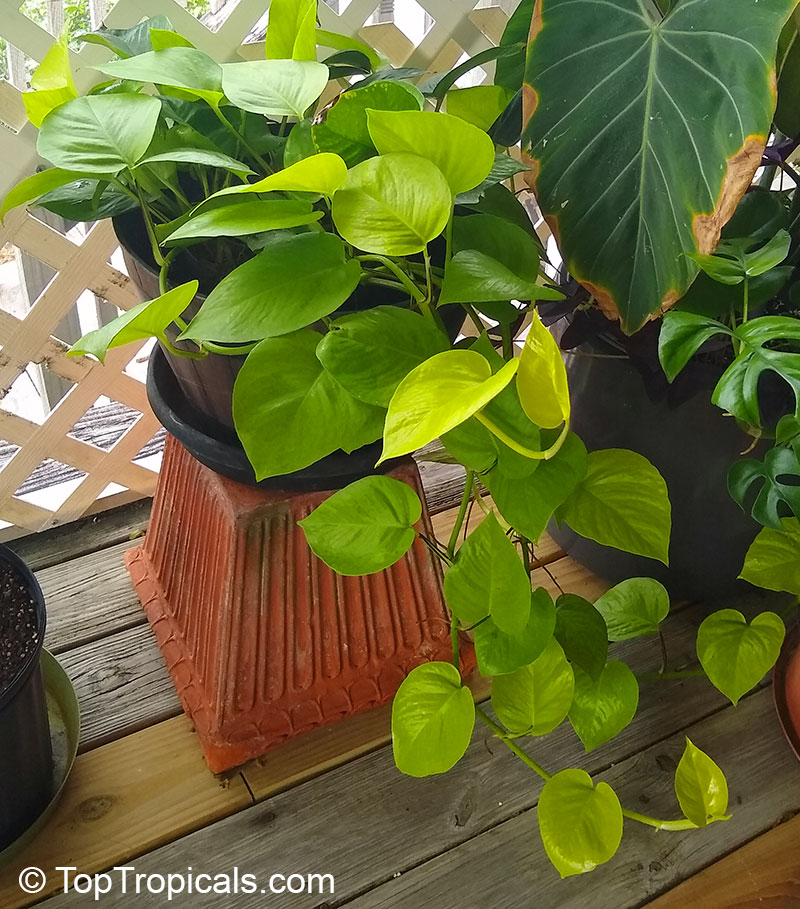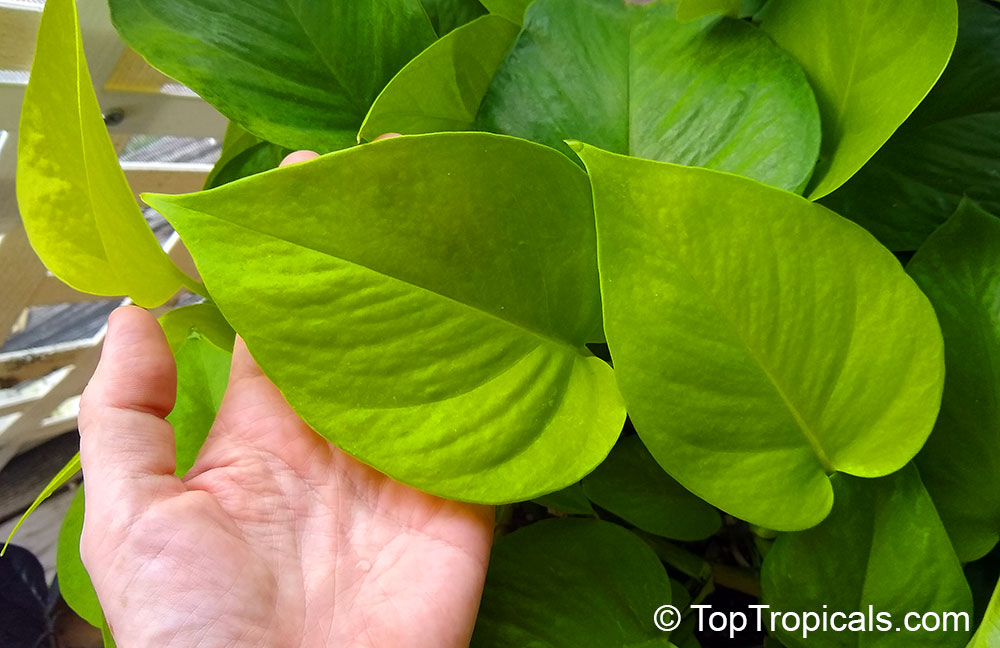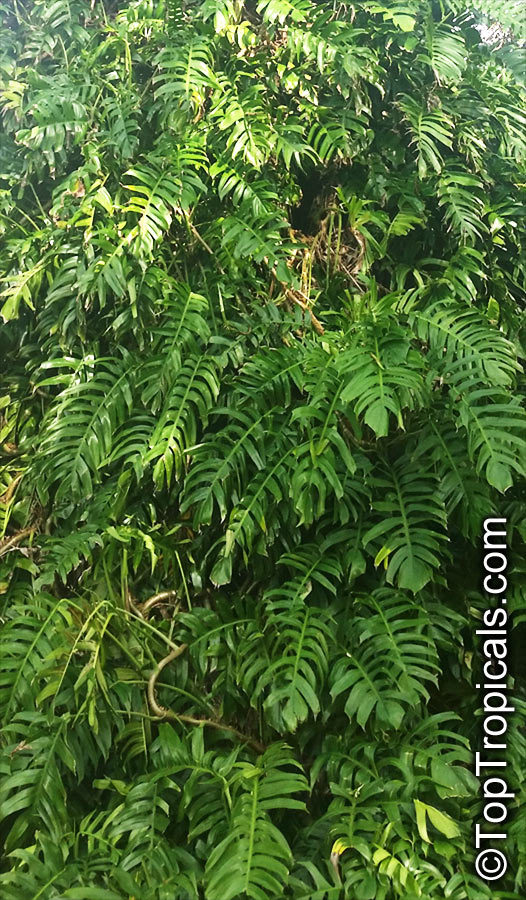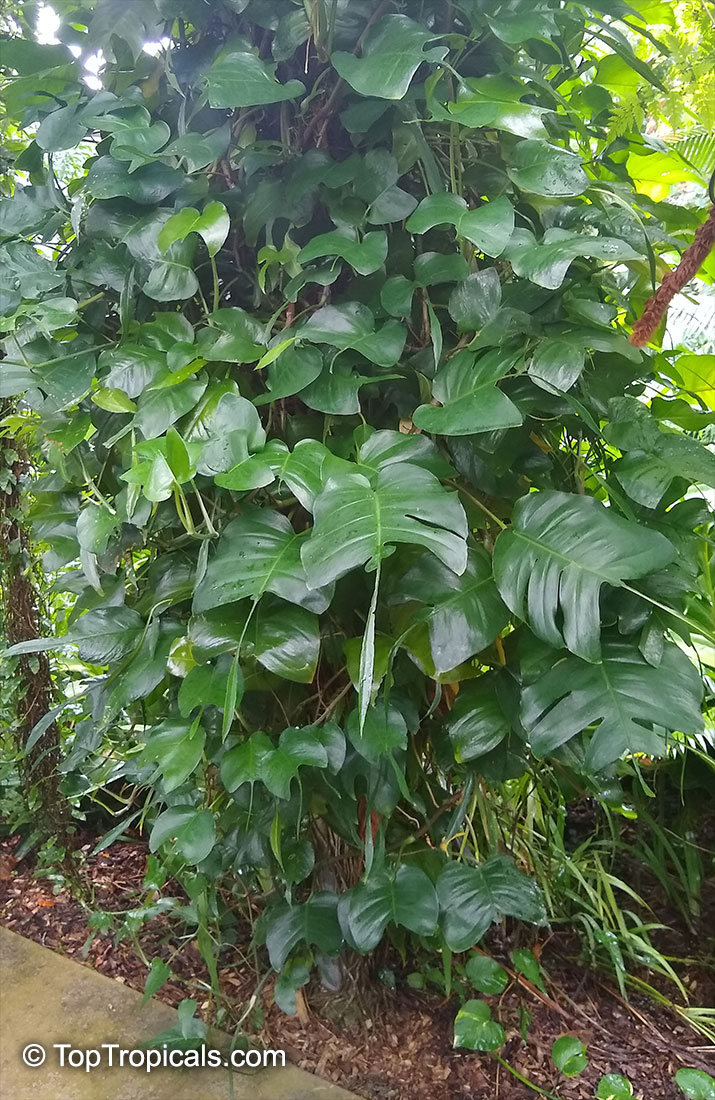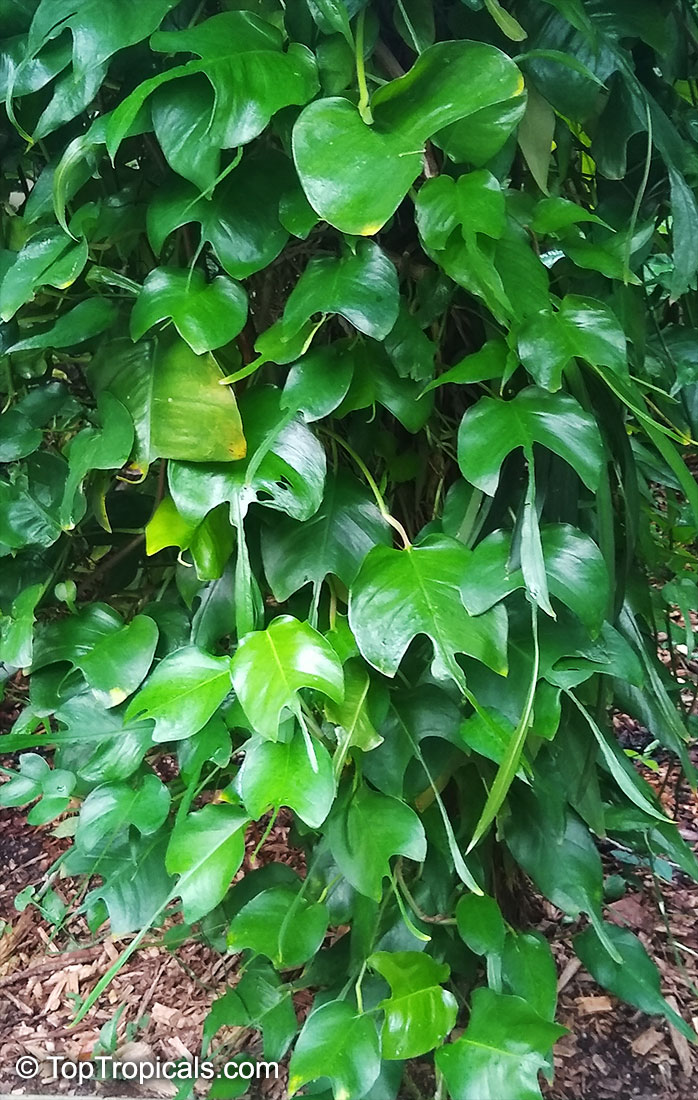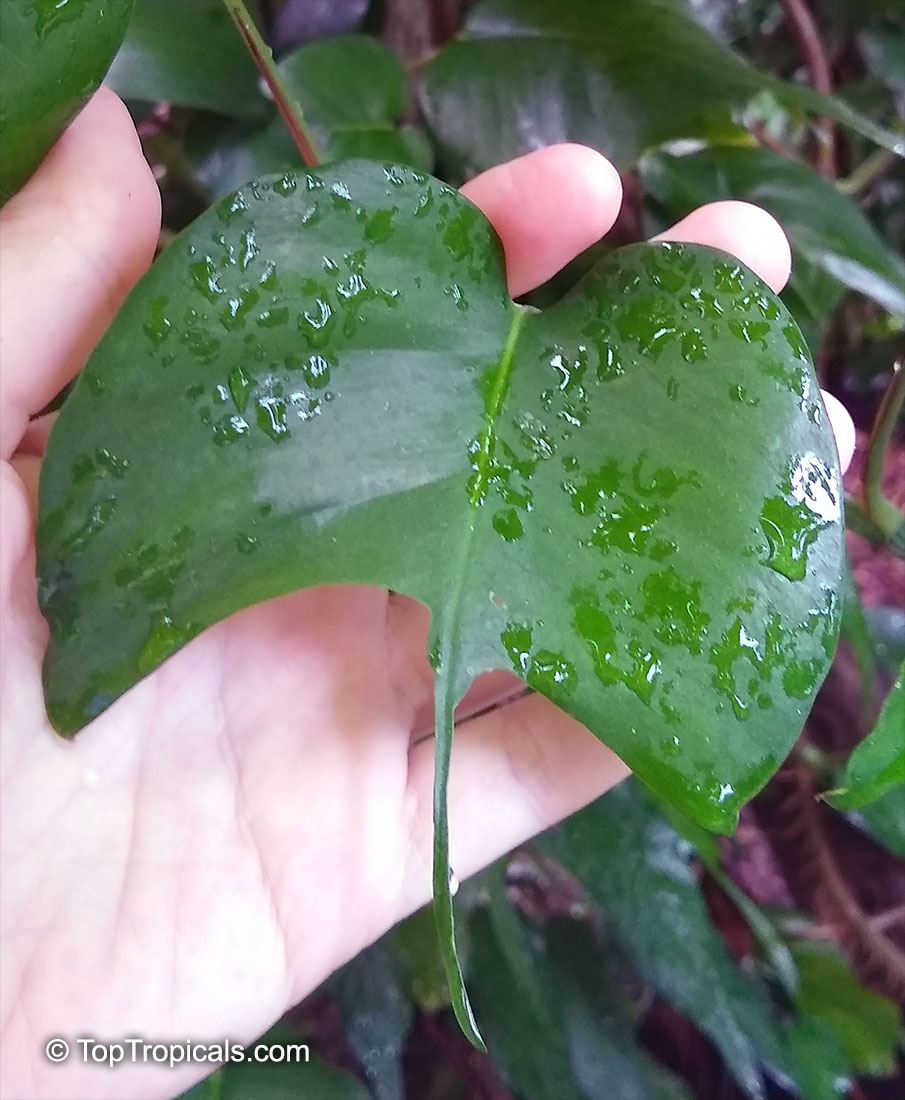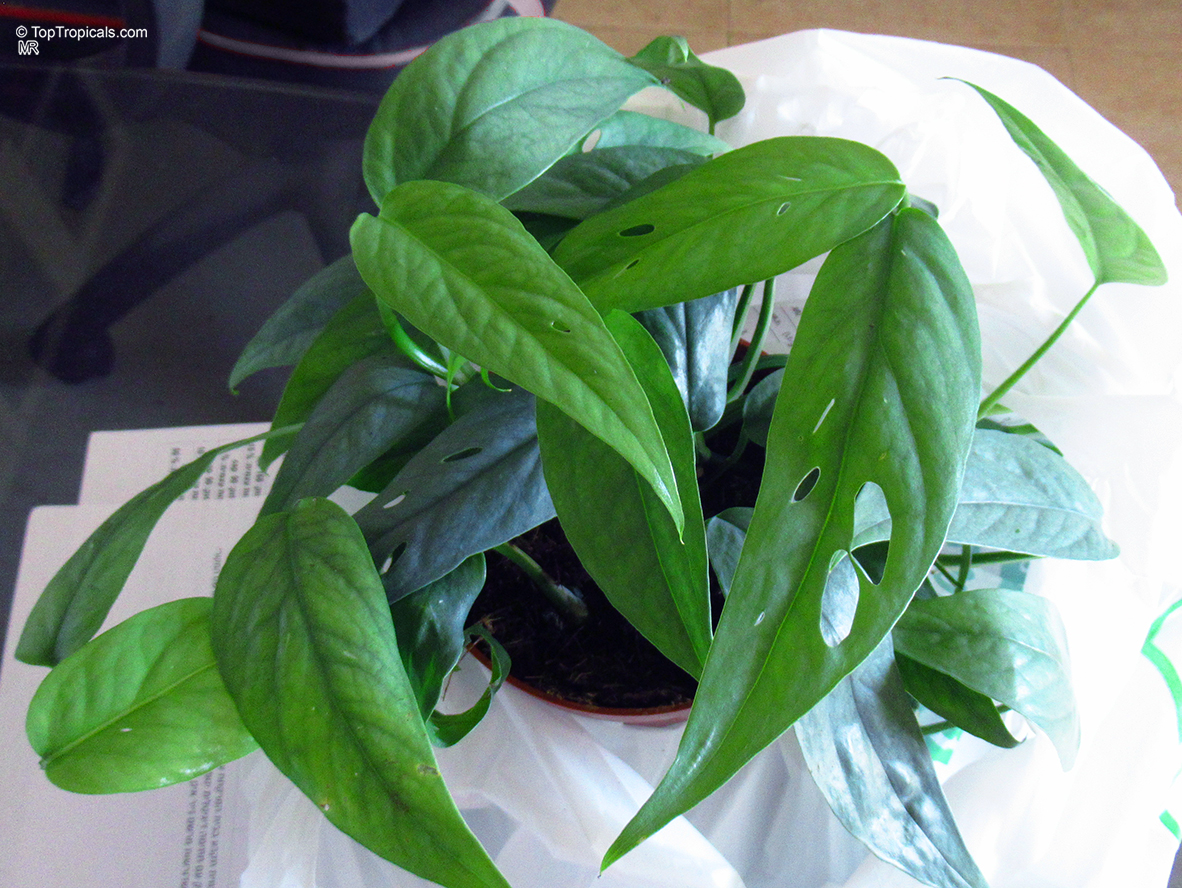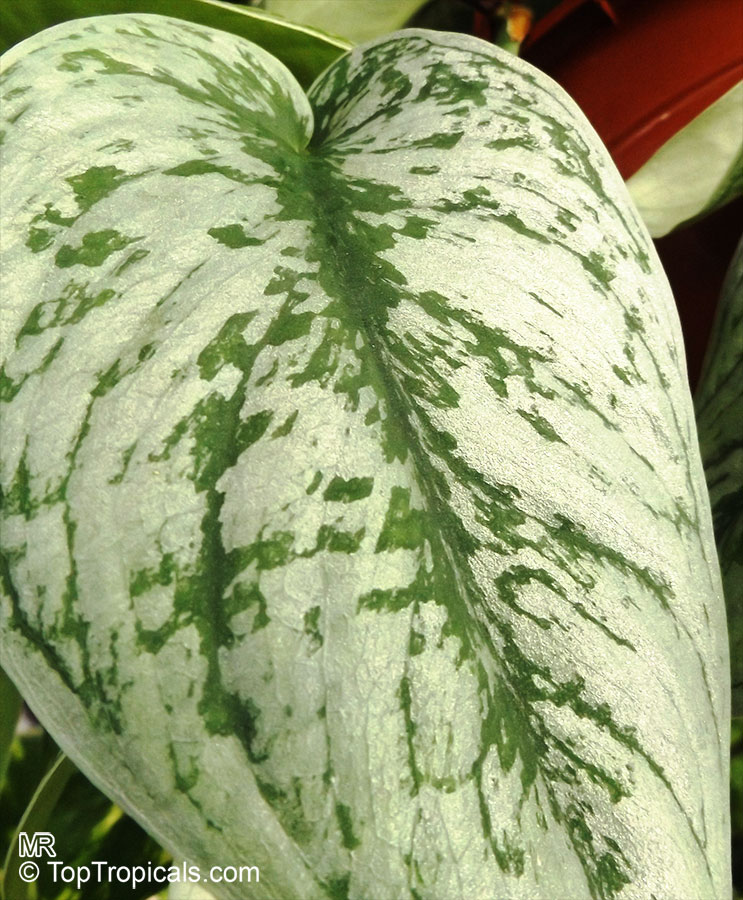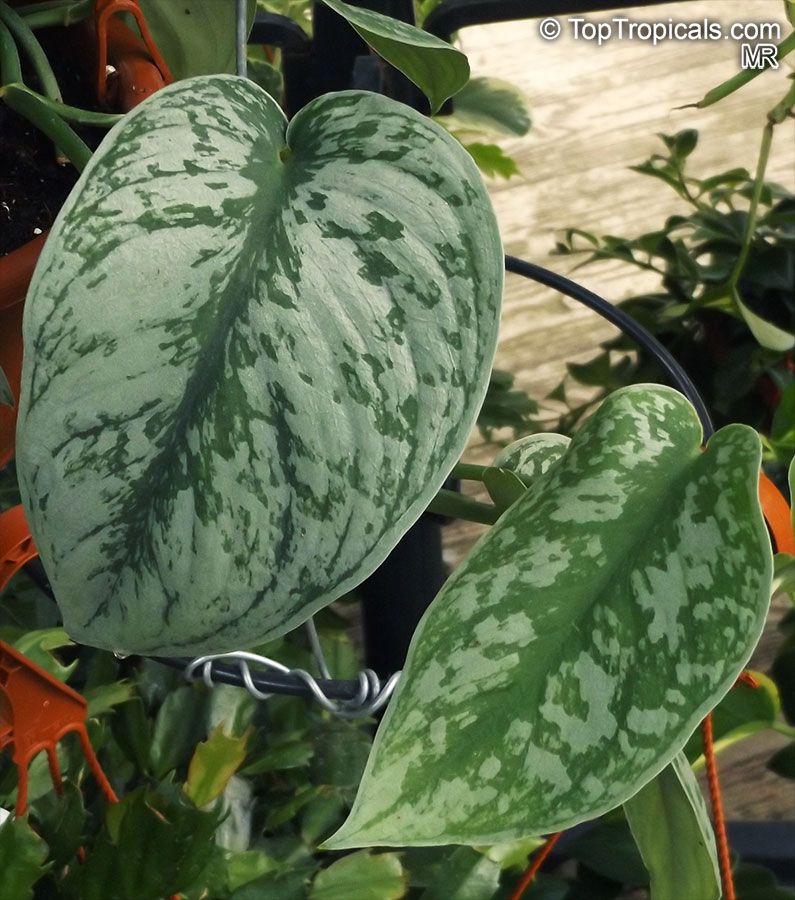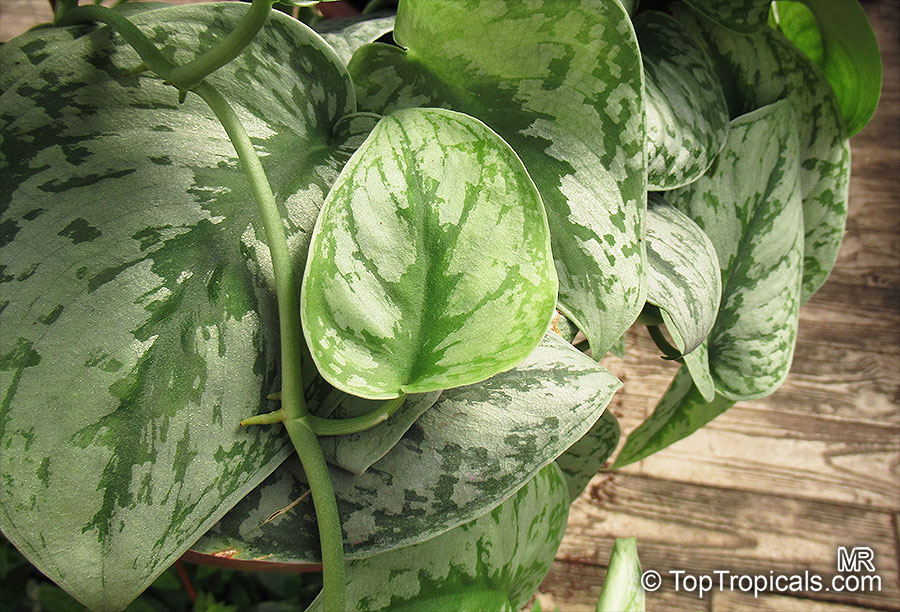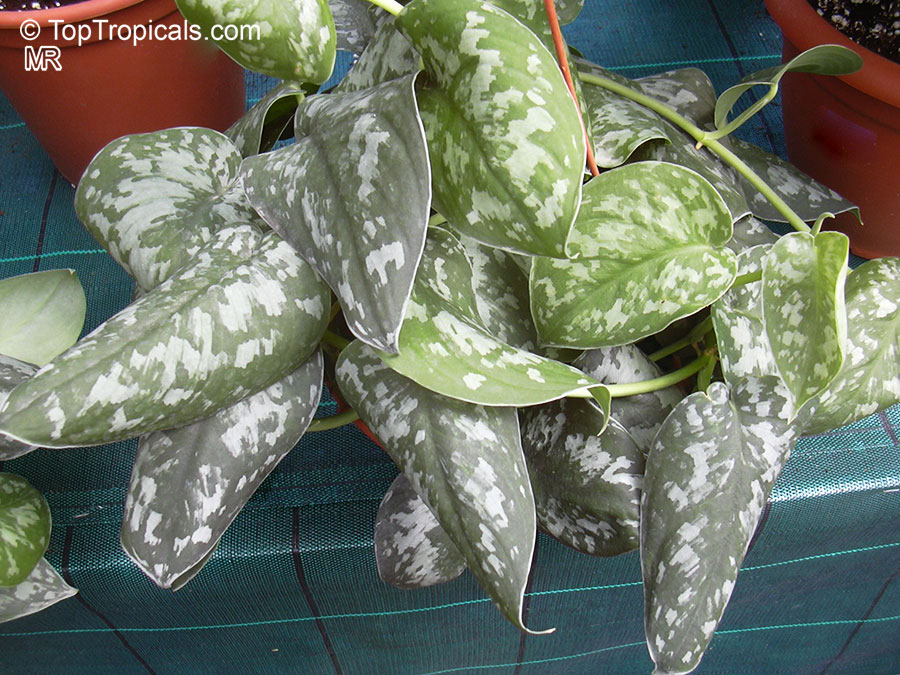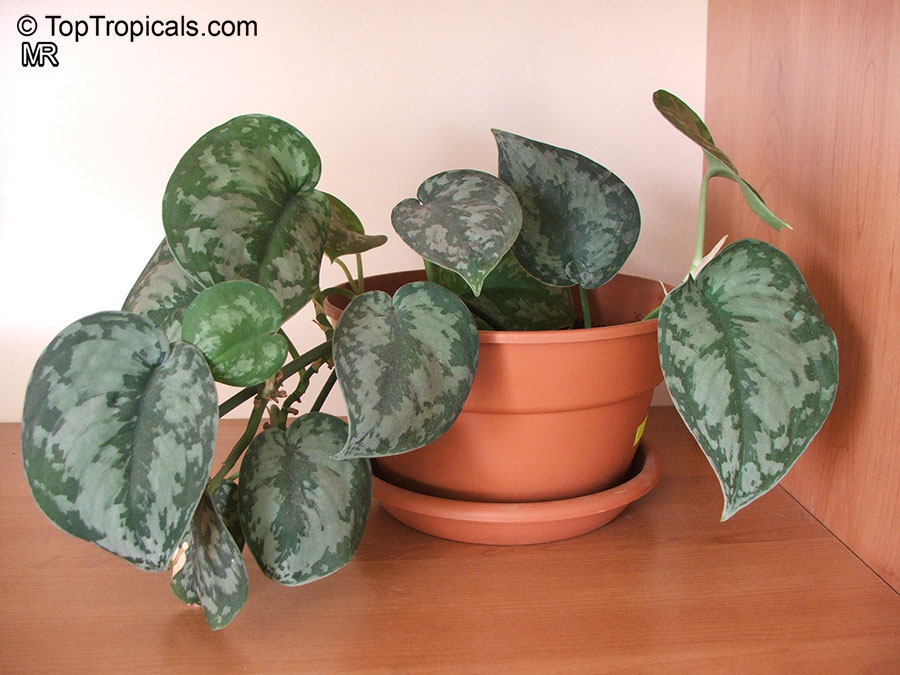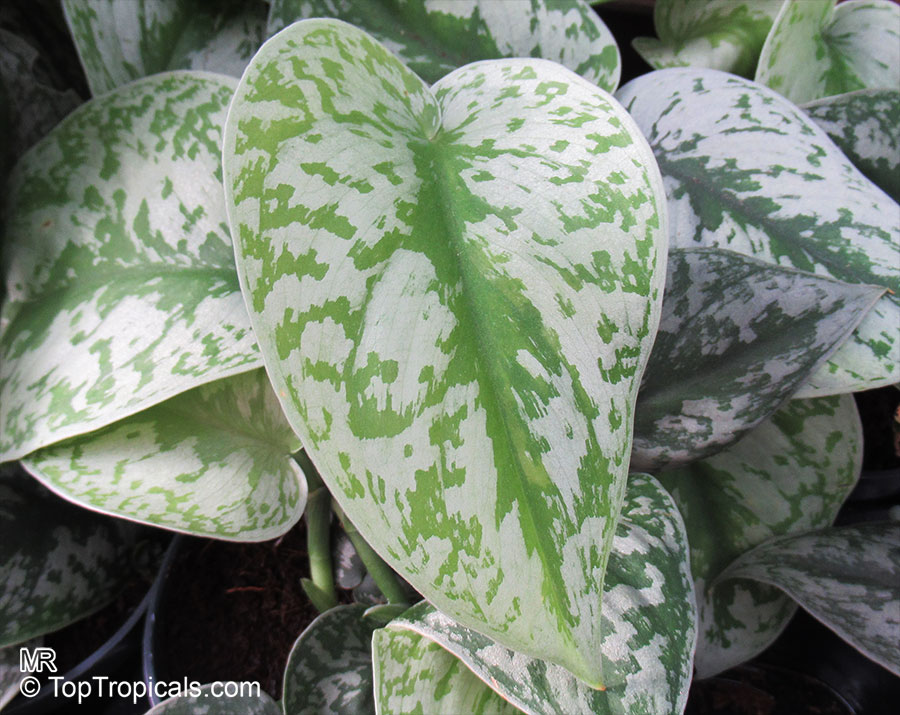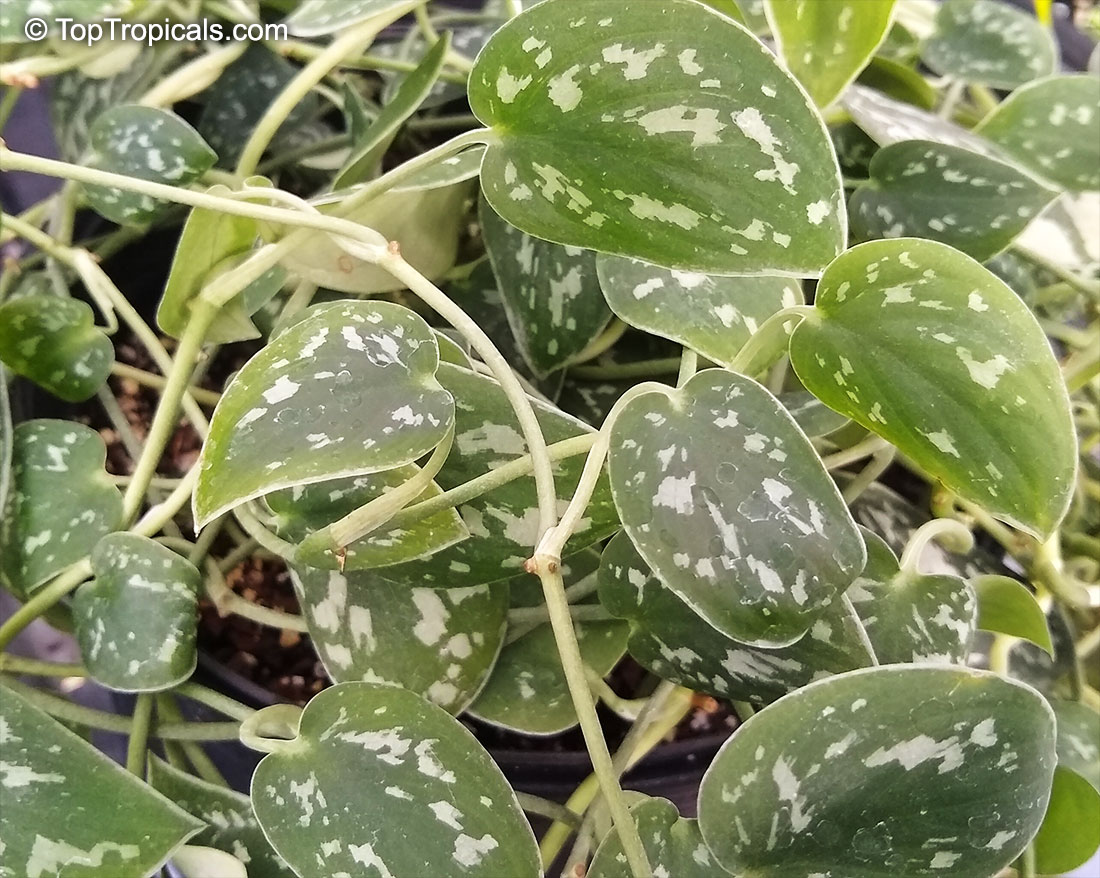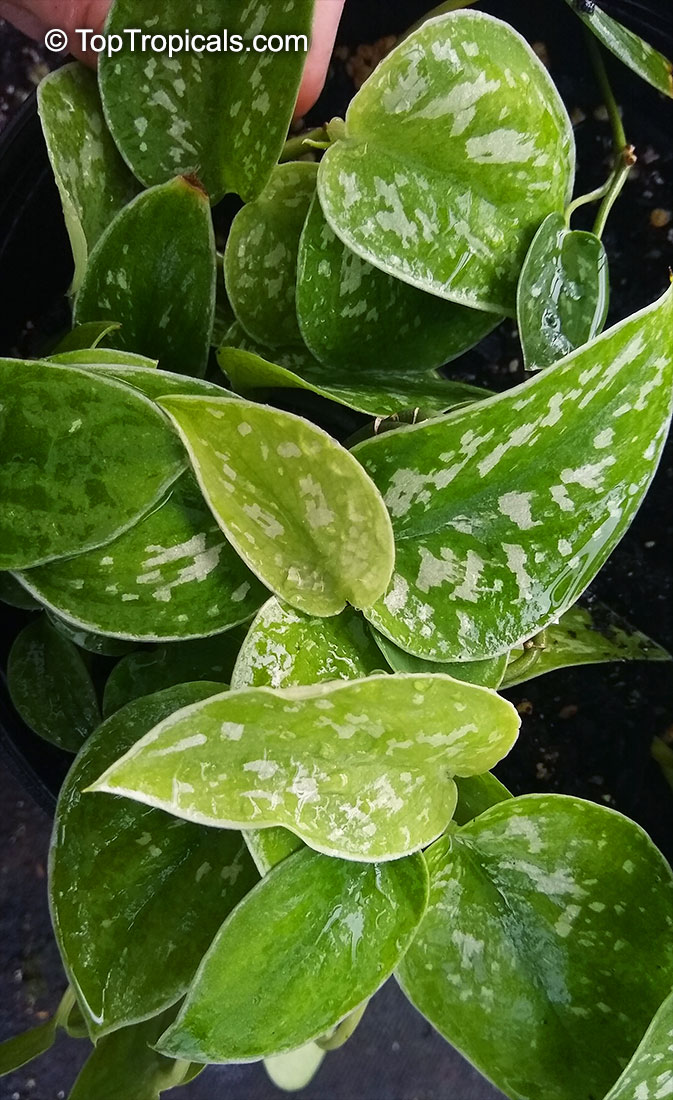Pothos - Plant Encyclopedia Results
Top Tropicals Plant Encyclopedia
| Number of plants found: 7 |
Botanical names: Anthurium coriaceum, Pothos coriacea
Common name: Paddle-leaf Anthurium
Family: Araceae
Origin: Brazil




Botanical names: Epipremnum aureum, Epipremnum pinnatum var. Aureum, Scindapsus aureus, Pothos aureus
Common names: Pothos, Money Plant
Family: Araceae
Origin: Southeast Asia
Hardiness: 30°F








It is a liana growing to 60 ft tall, with stems up to 1,5 in diameter, climbing by means of aerial roots which hook over tree branches. The leaves are evergreen, alternate, heart-shaped, marbled with creamy white or gold, entire on juvenile plants, but irregularly pinnatifid on mature plants, up to 3 ft long and 18 in broad.
It is a popular very hardy houseplant with numerous cultivars selected for leaves with white, yellow, or light green variegation.
Plant is said to bring good luck and prosperity in the house.
This species has been assigned to a number of genera. In 1880 when it was first described, it was named Pothos aureus, which is in part why it is often commonly referred to as a "pothos". After a flower was observed in 1962, it was given the new name of Raphidophora aurea. However, after closer examination of the flower, researchers noticed its heightened similarity to Epipremnum pinnatum and synonymised it with that species. Only after further observations of all parts of the plant, including the leaves and growing patterns, was it again separated from E. pinnatum, as E. aureum.
The plant has a multitude of common names including golden pothos, Ceylon creeper, hunter's robe, ivy arum, house plant, money plant, silver vine, Solomon Islands ivy, marble queen, and taro vine. It is also called devil's vine or devil's ivy because it is almost impossible to kill and it stays green even when kept in the dark. It is sometimes mistakenly labeled as a Philodendron in plant stores. It is commonly known as money plant in many parts of the Indian subcontinent. It rarely flowers without artificial hormone supplements; the last known spontaneous flowering was reported in 1964.
The plant has gained the Royal Horticultural Society's Award of Garden Merit.
The plant is said to bring good luck and prosperity in the house. It is also called devil's vine or devil's ivy because it is almost impossible to kill and it stays green even when kept in the dark. It is sometimes mistakenly labeled as a Philodendron in plant stores. It is commonly known as money plant in many parts of the Indian subcontinent.
See Article about Philodendrons.
Recommended Fertilizer: SUNSHINE Robusta - Rapid Growth Booster
Last one
Botanical names: Rhaphidophora celatocaulis, Pothos celatocaulis
Common name: Shingle Plant
Family: Araceae
Origin: Borneo





Water shingle plant as the top two or three inches of the potting mix starts to dry to the touch. Take care not to overwater. If it stays wet for extended periods, its root may suffocate and rot.
Shingle plant prefers above-average humidity levels and can suffer if the air is too dry. Boost humidity in its environment by growing it in a large terrarium, over a large pebble tray, near a small humidifier, or grouped together with other houseplants.
Recommended Fertilizer: SUNSHINE Robusta - Rapid Growth Booster
Botanical name: Epipremnum aureum
Common names: Golden Neon Pothos, Golden Heart, Lemon Lime
Cultivar: 'Neon'
Family: Araceae





Epipremnum aureum Lime Gold (Neon) is a rarer form of the Epipremnum with lime green leaves. A vibrant yellow statement piece is this stunning heart leaf Epipremnum that produces long vines and works well in a hanging basket or trailing out of a pot; it can be also grown on a stake or trellis. This Epipremnum prefers moist but well-drained soil and some humidity.
Botanical name: Epipremnum pinnatum
Common names: Pothos, Money Plant
Family: Araceae






Epipremnum pinnatum or Pohtos is an evergreen vine or creeper that is grown in USDA Plant Hardiness Zones 10-11. It can reach heights of up to 60 feet and its stems can get up to 1.5 inches in diameter. The leaves are heart-shaped and alternate and can grow up to 3 feet long and 18 inches wide. The juvenile plants have entire leaves but on mature plants, the leaves become irregularly pinnatifid. There are many attractive and hardy cultivars of this plant, such as the Epipremnum pinnatum "Skeleton Key" which starts with Pothos-like (Epipremnum aureum) leaves but as it climbs and matures, the leaves transform into a skeleton key shape.
When growing Epipremnum pinnatum, it does well in areas that provide semi-shade to full shade and it needs regular watering. It is best to water the plant moderately and make sure to never over water it as this can be irritating to the plant. When kept in a pot in colder regions, it's beneficial to provide the plant with extra protection during winter months by moving it to a warmer spot. This will ensure it incurs know frost or snow damage.
Botanical names: Scindapsus pictus, Epipremnum pictum
Common names: Satin Pothos, Silk Pothos, Silver Philodendron
Cultivar: 'Argyraeus'
Family: Araceae
Origin: Southeast Asia






This plant is cultivated for satiny dark green juvenile leaves which are heart-shaped with irregular silver spots. Light green foliage is spotted with silvery, reflective variegation. The heart-shaped leaves are velvety to the touch and matte in texture, which has led this plant to have the common names Philodendron Silver and Satin Pothos (though botanically it is neither Philodendron nor Pothos). Eventually, its vines grow quite long, making Scinapsus pictus a great choice for hanging planters.
Recommended Fertilizer: SUNSHINE Robusta - Rapid Growth Booster
Use link to repeat this search:
https://toptropicals.com/cgi-bin/garden_catalog/cat.cgi?find=Pothos&search_op=and&keyword_op=and&language=e&number=10
&no_change_lang=1&user=tt&sale=1&first=0


